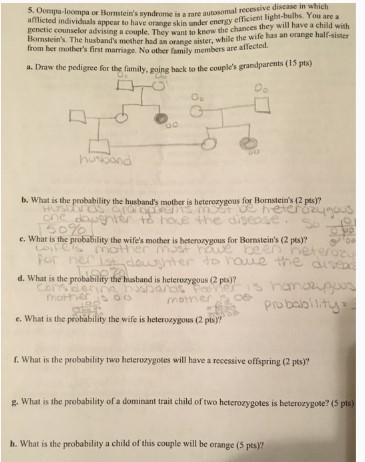QQuestionAnatomy and Physiology
QuestionAnatomy and Physiology
8. Oompa loompa or Bornstein's syndrome is a rare autosomal recessive disease in which afflicted individuals appear to have orange skin under energy efficient light-bulbs. You see a genetic coomarker advising a couple. They want to know the chances they will have a child with Bornstein's. The husband's mother had an orange sister, while the wife has an orange half-sister from her mother's first marriage. No other family members are affected.
a. Draw the pedigree for the family, going back to the couple's grandparents ( 15 pts )
b. What is the probability the husband's mother is heterozygous for Bornstein's (2 pts)?
c. What is the probability the wife's mother is heterozygous for Bornstein's (2 pts)?
d. What is the probability the husband is heterozygous (2 pts)?
e. What is the probability the wife is heterozygous (2 pts)?
f. What is the probability two heterozygotes will have a recessive offspring ( 2 pts )?
g. What is the probability of a dominant trait child of two heterozygotes is heterozygote? (5 pt)
h. What is the probability a child of this couple will be orange ( 5 pts )?
Attachments

6 months agoReport content
Answer
Full Solution Locked
Sign in to view the complete step-by-step solution and unlock all study resources.
Step 1I'll solve this genetics problem step by step, focusing on the probability calculations for Bornstein's syndrome.
- $$b$$ = Bornstein's syndrome allele (recessive)
Let's define the alleles:
Step 2: Pedigree Analysis
- Husband's mother has an orange sister, suggesting she is likely heterozygous $$Bb
- Wife's mother has an orange half-sister, suggesting she is also likely heterozygous Bb
Final Answer
a. Pedigree would show carriers in both maternal lines b. Husband's mother: 100% heterozygous c. Wife's mother: 100% heterozygous d. Husband: 50% heterozygous e. Wife: 50% heterozygous f. Probability of recessive offspring: \frac{1}{16} (6.25%) g. Probability of heterozygous dominant child: \frac{2}{3} \times \frac{3}{4} = \frac{1}{2} (50%) h. Probability of orange child: \frac{1}{16} (6.25%)
Need Help with Homework?
Stuck on a difficult problem? We've got you covered:
- Post your question or upload an image
- Get instant step-by-step solutions
- Learn from our AI and community of students